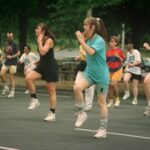The forearms are, without a doubt, the muscles to which the fewest exercises are dedicated directly in the planning of any type of routine. In most grip exercises, their correct execution or weight gain will largely depend on the capacity of our forearms. If external elements, such as handles, are not used, some exercises may not work due to lack of limb maneuverability.

What are forearm exercises?
Forearm exercises are all those movements designed to strengthen the entire muscle complex that makes up the forearm. This muscle group is made up of three compartments: anterior, lateral, and posterior. The anterior compartment has the function of allowing the flexion of the hand, the wrist and each one of the five fingers of each hand. The lateral, on the other hand, allows the flexion of the entire part of the forearm near the elbow, as well as the rotation of the forearm in the middle position. Finally, the posterior compartment plays the role of allowing the extension of the fingers and elbows.
For aesthetics and for not being a too striking muscle group, the forearms are the great forgotten of any type of fitness routine. However, they play a fundamental role in all training. Except for the legs, for the most part, the forearms act indirectly in the training of the rest of the muscle groups such as the pectoral, biceps, triceps and even the back in the execution of a dead weight.
However, special care must be taken in the execution of all forearm exercises. It makes up a large number of nerves and fibers and is one of the main sources of injury to the body. As has been said before, they support a great amount of pressure indirectly since practically all the movements that are made pass through the forearms.
The advantages of training the forearms
As with the legs, a muscle group considered to be of minor importance by many, the forearms are of paramount importance in facilitating the growth of other muscles that we care for the most. Therefore, training and performing forearm exercises has multiple advantages. The most prominent are the following:
- The forearms are responsible for supporting the development of other muscles such as the biceps, triceps, along with the pectorals, shoulders and back exercises.
- For some, the forearms may have aesthetic significance. Surely it will be the least of the reasons to include them in the routine, but for others, this muscle group can be synonymous with giving a vision of strength to others.
- The forearms act as a connection between the hands and other muscle groups. Some exercises like deadlifts require good strength in this muscle group.
- Helps prevent injuries and improves everything related to grip exercises outside the gym. The clearest example is climbing.
Before any symptom of pain it is highly recommended to go to a specialist in physiotherapy. An injury to the forearms can mean a long period of time without training and weighing down and penalizing our routine and the objectives to be achieved in the medium and long term.
How to do forearm exercises
Climbing a rope, performing rowing exercises, or simply carrying out a deadlift is synonymous with strengthening our forearms. These types of routines, in addition, are also the perfect complement to strengthen other muscle groups. The first exercise presented to us is a simple pull-up, although we will add a towel. The towel will add a certain degree of difficulty in the grip and will have more impact on the target. The muscular area that will hold our body weight will be the forearms themselves. Giving frequency to this type of exercise will strengthen the forearms. In this same exercise there is another type of variable, which varies the type of grip. Instead of using a towel, we can also use the same shirt to perform the type of pull-up known as “Side-to-Side”, with a slightly more closed grip. While in the first type of pull-up we will also focus on the dorsal, in the second we will strengthen the triceps.
The next exercise will be performing what for many will be a normal biceps curl. However, instead of taking the small, or Z-type bar, the use of an Olympic bar is recommended. By weight and length it will be better suited to the type of exercise we want to do. The execution will be carried out with one hand and following the normal movement of a biceps curl. However, the objective is to try to maintain the balance of the forearm at all times and we will begin to notice the work. Once we have finished with one arm, we will do the same exercise with the other. Continuing with the curl, and sitting on a bench, we will perform the wrist curl, a muscular part quite forgotten for most athletes. With a dumbbell, we will perform the movement of the biceps curl but with the wrist. In this type of exercise you can also look for muscle failure. It is not difficult to find, since it will occur when we cannot hold the weight itself. Once we have finished with one arm, we will perform the same type of exercise with the other arm.
In order to include some cardiovascular work in our forearm exercise routine, the farmer’s walk is the perfect example since it gives us both. Although the main work is focused on the grip, it also includes isometric contractions and, therefore, the beats per minute of our body will begin to increase until it skyrockets. The only requirement is that the weight loads must be large to enhance the grip work, such as dumbbells or farmer’s bars, special for this type of exercise. The execution will consist of lifting the weight from the ground slowly and with correct technique and walking slowly a few weights and leaving the weight on the ground, and repeating the process. It is a perfect exercise to include in a metabolic circuit.
Another type of training that we can try to strengthen our forearms is based on grip with utensils. In this facet, everything that is to interpose an obstacle to increase the grip will be beneficial to achieve our goals. In this sense, the so-called “Fats Grips” are ideal for performing forearm exercises. Thus, the exercises explained above such as curls or rows can be performed with much less weight but achieving muscle fatigue beforehand. In addition, we will also find the «hand grip», designed to perform exercises to work on the strength of the hand in a specific way, but where the muscles of the forearms also intervene.
Finally, the kettlebell grip exercises will allow us to increase the strength of our forearms, while improving our coordination. In turn, it is possible to carry out this type of training progressively since it allows the possibility of gradually increasing the weight. All in all, we have multiple ways to stimulate our forearms combined with the development of other muscle groups. There is no excuse to work what is, without a doubt, the forgotten muscle group of our body.

















